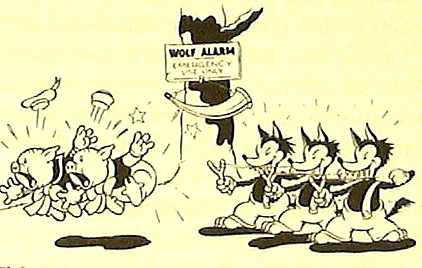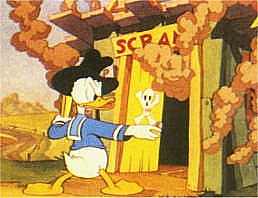| During his life Barks worked
as farmhand, writer, machinist, chicken
farmer, cartoonist, in-betweener, comic
book artist, grape picker, producer,
traincar repairman, gagman, sawmill
worker, plum picker, painter, carpenter,
printshop assistant, oil worker,
cattlestation worker, artist, logger,
editor, factory worker, rivet heater,
cowhand, farmer, muleskinner, and
storyteller. |
|
| During his years as an in-betweener
at Disney's, Barks received 20 dollars
per week. |
|

Barks' first encounter with the work of
the Disney Studios was the cartoon Three
Little Pigs from 1933 which he saw in the
local cinema. He was later set to work as
an in-betweener on a sequel called Three
Little Wolves from 1936. |
|
| While Barks was living with
his family in Roseville, California, he
attempted to write short stories. But he
quickly gave up the work at the
typewriter, because he felt that his
English was not good enough. |
|
| After one year as an
inbetweener at 20 dollars a week Barks
was transferred to the story department
which paid 65 dollars weekly. |
|
| When the idea of introducing
the three nephews to the cartoons arose,
Barks worked at the story department and
he was against the idea. It would just be
two more characters to draw, he felt. |
|
| Several famous
people were born on March 27th: King Henry 2. of
England 1133
Italian composer Arturo Toscanini 1867
Hungarian composer Béla Bartók 1881
American actress Gloria Swanson 1899
American storyteller Carl Barks
1901
British film instructor David Lean
1908
American singer Sarah Vaughan 1924
American actor David Janssen 1931
American singer Aretha Franklin 1942
British singer Elton John 1947
American singer Mariah Carey 1970
|
|
| Barks
sold his first drawing to the 'Calgary
Eye-Opener' for 2 dollars. |
|
| All of his life Barks had to
fight a multitude of allergies. One was
his lactose intolerance, which made it
impossible for him to digest dairy
products properly. He loved milk with his
breakfast cereals, but he had to use milk
substitutes. |
|
| Every time Walt Disney came
to be shown the full storyboard for an
upcoming Donald Duck cartoon (in which
Barks was often the presenter) he would
spen ten minutes studying all the
sketches before the official presentation.
During the presentation an exchange of
ideas would fly back and forth between
Disney and the crew involved. |
|
| Supposedly, Barks'
extraordinary talents were spotted early
in his first months at Disney's, because
he received a weekly pay of 20 dollars
which was 2 dollars more than the other
beginners. |
|
|
| As soon as Barks had been
hired to work for Disney's in 1935 he was
sent to the company's art school. Only 4
made it. Barks was one of them... |
|
| The Barks family grew all
the produce they could for their own
consumption on the farm, but once in a
while they had to go to neighbouring
Merrill to buy additional necessities.
They rode in a surrey with the parents in
the front seat and the two kids in the
back. |
|
| Barks
did not participate in the great strike
at Disney's in 1941. At the time he was
in the story department and it was just
the animation departments that were on
strike. Furthermore, he was against the
strike which he felt was destroying some
of the spirit in the studios. |
|
| Carl, as a child, had had
the hard measles (Rubeola) that left him
almost deaf. He had several devices in
his home to help with listening to music
and to allow him to hear television
programs. |
|
| Barks' Zodiac sign was Aries.
People born under the sign are resolute,
enterprising, independent, competitive,
confident, outspoken, practical, born
leaders, and energetic. But they can also
be ruthless, impatient, impulsive, self-centred,
childish, and short-tempered. |
|
| Barks'
first wife, Pearl Turner, was the
daughter of Will Turner, who managed the
sawmill in Merrill with his brother. |
|
| Mother
Arminta knew that her two boys were not
fond of the farm's carrots so she began
to use them for 'pumpkin pies' instead.
Carl later admitted that he could not
understand from where she got all those
pumpkins! |
|
| As
a boy, young Carl would draw on every
scrap of paper he could lay his hands on.
He even used the margins of newspapers.
When he was working with the farm's
horses, he would draw in the dust on
their harnesses during breaks! |
|
| When
the Barks family went to Klamath Falls in
order to buy supplies, the trip would
take two days in a horse-driven surrey.
Today, you can drive there in 20 minutes. |
|

Two of the Donald Duck cartoons in which
Barks was involved were nominated for an
Academy Award (Oscar): Good
Scouts from 1938 and Truant
Officer from 1941. The winners
turned out to be Ferdinand the Bull and
Lend a Paw - both also from the Disney
Studios. |
|
| Barks' early business cards
simply read 'Artist'. |
|
| I remember there in
Oregon on the home ranch, there was a
dust problem from the wind blowing off
the ploughing fields, and my mother got
fed up with taking the curtains down and
washing them. They had to wash everything
by hand in those days. She got the idea
of making little stencils like doilies
and painting patterns on the windows so
they looked like lace curtains. It saved
all that washing, because you could look
in from the outside and think, well, that
house has got curtains up. |
|
|